
Gemini (also known as Gemini) is positioned in the celestial hemisphere of the north and is the third constellation of the zodiac.
- Abbreviation: Gem.
- Size: It is of medium size and is the 30th largest, covering an area of 514 square degrees.
- Location: It is situated in the fourth part of the northern hemisphere (NQ2).
- Visible range of latitude: It spans from +90 to -60 degrees.
- Vertical ascent: 7 hours.
- Declination: 20 degrees.
- Meridian crossing: It crosses the meridian at 2100 hours on February 20.
- Meteor showers: Geminids.
- Neighboring constellations: Ascendant, Cancer, Little Dog, Lynx, Unicorn, Orion, and Taurus.
The Almagest catalog, compiled by the renowned Greek scientist Claudius Ptolemy during the second century, initially featured the constellation Gemini. This constellation is said to symbolize the two brothers known as Castor and Pollux, also referred to as the Dioscuri, who were believed to be the offspring of Zeus or Jupiter, the supreme god.
Gemini is an exquisite constellation that is easily identifiable. It is most prominent in the winter months, specifically December to January. The arrangement of stars within the constellation closely resembles two human figures, making it easily comprehensible even for beginners. The stars Castor and Pollux serve as the heads of the twins, with their bodies extending towards the Milky Way.
Mythological Twins
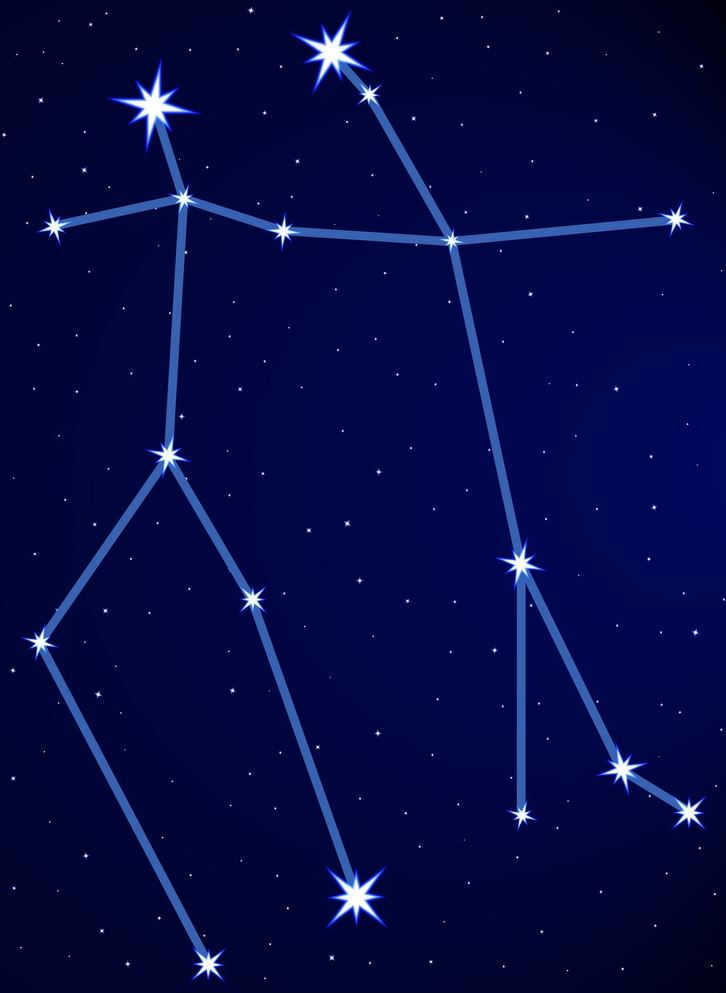
In Greek mythology, Castor and Polydeuces (Pollux) were not biological twins, but they were born to the same mortal mother named Leda, albeit to different fathers. Only Polydeuces was the son of Zeus, which granted him immortality. Despite their mixed parentage, the two boys grew up together and were inseparable.
Legend has it that the twins had a conflict with another pair of mortal twin brothers named Idas and Lynceus. The cause of the conflict was the abduction of Leucippus’ two daughters, Theba and Hilaera, by Castor and Polydeuces. In the ensuing fight, Castor was killed by Idas, while Polydeuces slew Lynceus.
The legend surrounding the brothers imparts a sense of familial affection and bravery to the constellation, while also symbolizing the juxtaposition of life and death intertwined with eternal existence.
The representation of Gemini in the night sky varies depending on the cultural context. In Arabic astrology, the constellation is depicted as two majestic peacocks, while in Egyptian astrology it is portrayed as twin goats. In ancient Rome, it was believed that the constellation represented the legendary founders of Rome – Romulus and Remus.
The primary stars of the constellation
- Named after the eternal sibling from ancient Greek mythology.
- Designated as the beta star of the constellation.
- Ranks as the 17th brightest in terms of luminosity.
- Has a stellar magnitude of +1.15.
- Located at a distance of 34 light-years from us.
- A massive star that is 750 times larger than the Sun.
- Serves as the head of the left twin.
- Named after the mortal twin.
- Designated as the alpha star of the constellation.
- Ranks as the 23rd brightest.
- Visible stellar magnitude: +1.62.
- Located at a distance of 51 light-years.
- Composed of 6 stars divided into three pairs.
- Marks the head of the right twin.
- A spectral double star.
- Ranks 43rd in terms of brightness.
- Has a stellar magnitude of +1.92.
- It is located 109 light-years away from Earth.
- 35 times larger than the sun.
- It represents the left foot of Pollux.
- It is a fixed star.
- Ranks as the 287th brightest star.
- Its stellar magnitude is +3.5.
- The distance from Earth is 59 light-years.
- 13 times bigger than the sun.
- It is commonly known as Pollux’s pelvis.
- Being a supergiant, it is 2.8 million times larger than the Sun.
- Situated at a distance of 840 light-years.
- Ranks as the 185th brightest star.
- It marks the pelvis of Castor.
- In Arabic, its name means the folded paw of a lion.
- Has a visible magnitude of +4.2.
- The distance from Earth is 1200 light-years.
- It is the left knee of Pollux.
Other stars in the Gemini constellation
- U Gemini (U Geminorum) is a binary star system that experiences periodic flares once every century. It was first observed by John Russell Hynde in 1855 and is located approximately 400 light years away from Earth. The apparent magnitude of U Gemini can vary between 14 and 15.
- Mu Gemini (Mu Geminorum) is a Red Giant star and is the 4th brightest star in the constellation Gemini. It has an apparent magnitude of 2.8 and is located approximately 230 light-years away from Earth. Mu Gemini is also known for marking the foot of Castor.
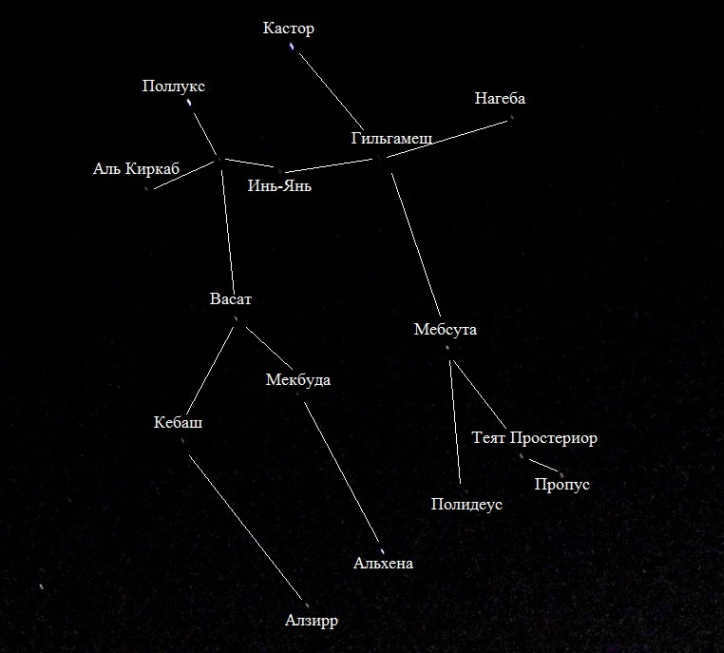
- Eta Geminorum (Eta Geminorum). A star system that consists of three stars. The brightness of this system can vary from 3.15 to 3.90. It is estimated to be 350 light years away from us.
- Xi Gemini ( Xi Geminorum, Alzirr). A subgiant star that is located at a distance of 59 light years from us. It is approximately 11 times brighter than our Sun and has an apparent magnitude of 3.3.
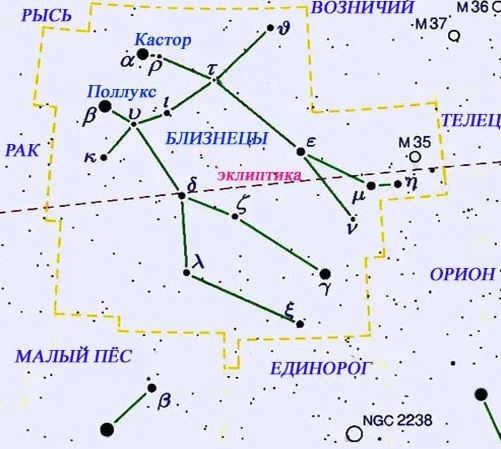
- Tau Geminorum is a bright orange giant star in the Gemini constellation. It has an apparent magnitude of 4.42 and can be observed without the need for special optical equipment under favorable conditions. The star is located at a distance of 321 light years.
Constellation Objects
In addition to being renowned for its collection of bright stars, Gemini also boasts fascinating celestial entities:
- Messier 35 (NGC 2168). This expansive open cluster was first identified in 1745. It is comprised of approximately 200 stars with a stellar magnitude of 5. Its distance from us is a mere 2800 light years.
- The Eskimo Nebula (NGC 2392). Classified as a planetary nebula with a magnitude of 9.2, it is positioned 4000 light years away from Earth.
- Medusa Nebula (Abell 21). A remnant of a galactic supernova, this planetary nebula was named after astronomer George O. Abell, who first discovered it in 1955. It is situated 1500 light years from our location.
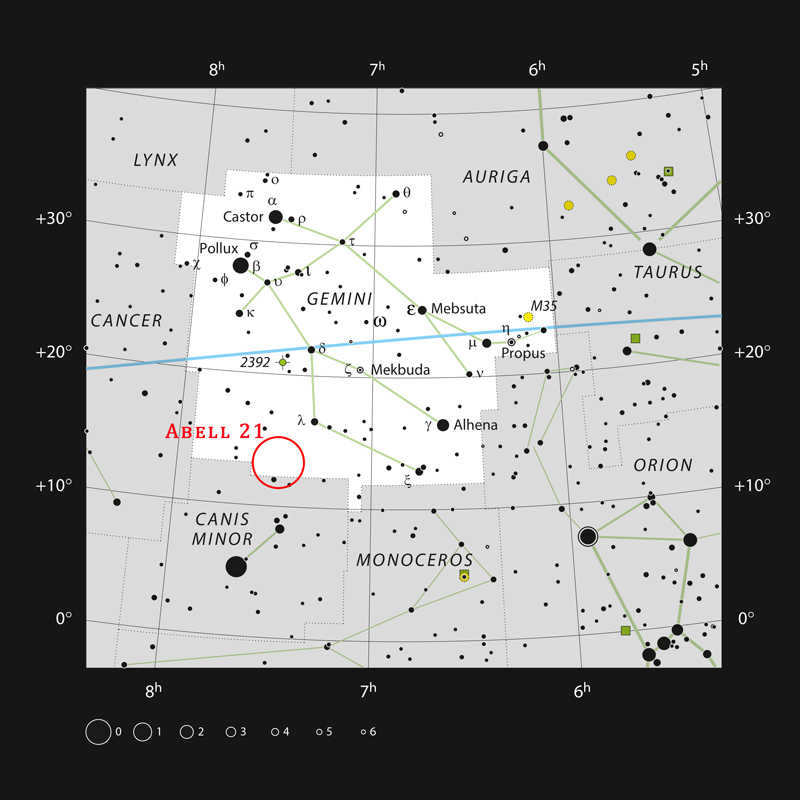
Not long ago, astronomers from China made a discovery in the Gemini constellation – they found a black hole that is truly remarkable in terms of its mass. It is a staggering 69 times bigger than our Sun, which is a size that was previously thought to be nearly impossible for the Milky Way.
Previously, it was believed that the largest stars in our Galaxy would shed most of their mass during the final stages of their life cycle. This would prevent them from producing black holes of such enormous proportions – the mass of this newly discovered black hole is nearly double what was previously considered possible. The scientific community will now have to grapple with the question of how these objects come into existence.
Where is it located?
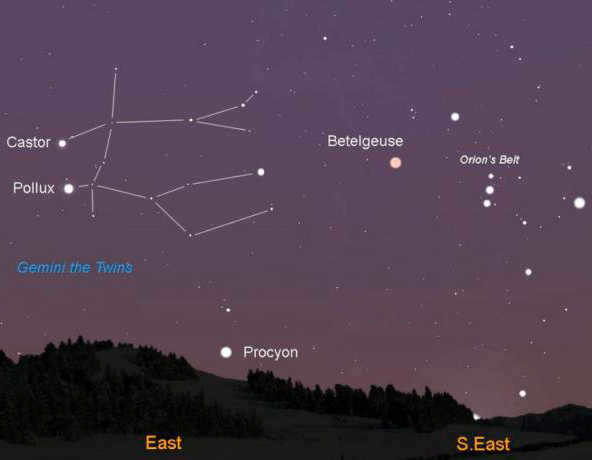
- Castor and Pollux – The most luminous stars in the constellation, distinguished as twin heads.
- The point of recognition – is Pollux, the 17th brightest star in the constellation.
The Gemini constellation is easily visible in the night sky, even for amateur astronomers. It is situated to the northeast of Orion and between the Taurus and Cancer constellations.
The ideal month for observing in both hemispheres is February. Gemini reaches its highest point in the sky around 10:00 pm local time at night during early February. In April and May, Gemini can be observed shortly after sunset.
- Gemini, a scientific and astronomical observatory, utilizes a pair of telescopes known as Gemini.
- Every year in the first half of December, the Geminids meteor shower occurs in this constellation.
- In Chinese culture, the stars Pollux and Castor in Gemini represent the concept of Yin and Yang.
- NASA’s Gemini program was inspired by the constellation Gemini.
Geminid Meteor Shower – This celestial event is a slow-burning meteor shower that occurs when meteors collide with the Earth’s atmosphere. As a result of this collision, stunning long arcs can be observed in the night sky.
Frequently Asked Questions
What is the largest and brightest star in the constellation, despite being labeled “β” by astronomer Bayer?
Does the ecliptic pass through the constellation Gemini because it lies along the Milky Way?
Is Pollux the brighter and more golden star in Gemini, while the other star has a bluish hue?
From June 21 to July 20, when does the Sun pass through Gemini?
How can Gemini be easily found in the sky?
By orienting yourself with Orion, which is about four times closer to the hunter’s right shoulder, you can find Gemini. This constellation is easily recognized by its short straight line of three stars, known as the Orion’s Belt asterism. To find Gemini, simply follow this line to the northeast.
Scientific Facts: A Video Review
The star pattern known as the constellation Gemini has a long history, dating back to ancient times. It was first observed by humans many centuries ago and was mapped by Claudius Ptolemy, an astronomer from Greco-Egyptian origin, as part of his sky mapping project. The name “Gemini” comes from the Latin word for “twins,” and most star chart creators depict the stars in this constellation as a pair of twin boys.
Search for the Gemini constellation in the sky, located near the Orion (which boasts some intriguing spots) and Taurus constellations. For observers in the northern hemisphere, it represents a collection of stars associated with winter, with Castor and Pollux as its two brightest stars that form part of an unofficial asterism known as the Winter Hexagon. This formation includes six prominent stars from the Gemini, Orion, Canis Major, Canis Minor, and Taurus constellations. Gemini appears as two elongated chains of stars extending downwards from Castor and Pollux, which serve as the heads of the celestial twins. The most straightforward way to locate it is by looking east of the V-shaped Hyades star cluster that forms the face of Taurus the Bull. The optimal views of this star pattern can be enjoyed when it is directly overhead during the early months of the new year. It remains visible until late spring, disappearing in the glow of the setting sun.
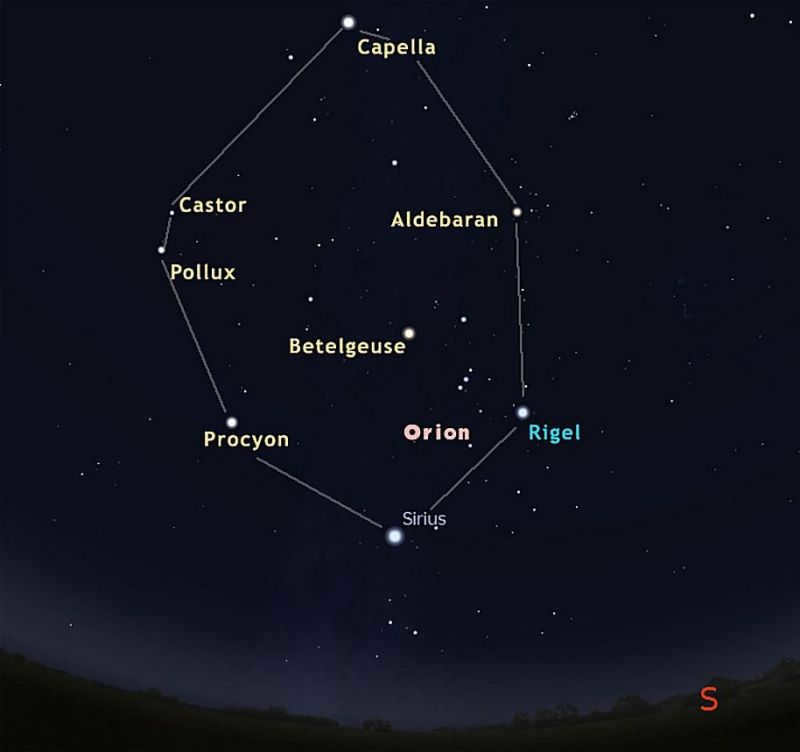
History of the Gemini Constellation
The mythology of the ancient Greeks and Babylonians revolved around a celestial duo. In the Babylonian culture, these celestial beings were considered divine and were identified as “Meshlamtea” and “Lugalirra.” They were closely associated with Nergal, a powerful deity who presided over the Underworld and was believed to bring about various calamities, illnesses, and other afflictions. On the other hand, the Greeks and Romans named these celestial bodies after the twin sons of Zeus and the maiden Leda. In Chinese mythology, these stars were envisioned as a bird and a tiger. The modern constellation representing the twins was originally defined by Ptolemy and later refined by subsequent astronomers. The precise region of the sky where the twins are located was officially designated by the International Astronomical Union and encompasses not only the primary stars but also other celestial objects and phenomena in deep space.
Stars in the Gemini Constellation
Within the Gemini constellation, the prominent stars Castor and Pollux take center stage. They are alternatively designated as α (alpha) Gemini (Castor) and β (beta) Gemini (Pollux). While Castor may appear as a solitary star, it is actually a collection of six stars orbiting one another. It is located approximately 52 light years away from Earth. Pollux, on the other hand, is an orange giant star and the twin brother of Castor. It resides at a distance of about 34 light years from our Sun. Additionally, Pollux has been found to host at least one planet in its orbit.
Astronomy enthusiasts seeking to observe other stars within the Gemini constellation can direct their attention towards ε (epsilon) Gemini. This particular star is noteworthy due to its status as a double star, visible through telescopes. Furthermore, one of the members of this pair is a variable cepheid star, which experiences fluctuations in brightness over a period of approximately 10 days.
Gemini doesn’t have a wealth of deep space objects. This is because they are situated away from the plane of the Milky Way, where the majority of clusters and nebulae can be found. However, there are a few things that stargazers can search for within this constellation. One notable object is a star cluster known as M35. Astronomers classify this as an “open” cluster, meaning that its stars are spread out across the universe while still traveling together. M35 is composed of approximately 200 stars and can be observed with the naked eye in a dark sky. It is also a stunning sight when viewed through binoculars or a telescope. Keep an eye out for it near the leg of Castor.
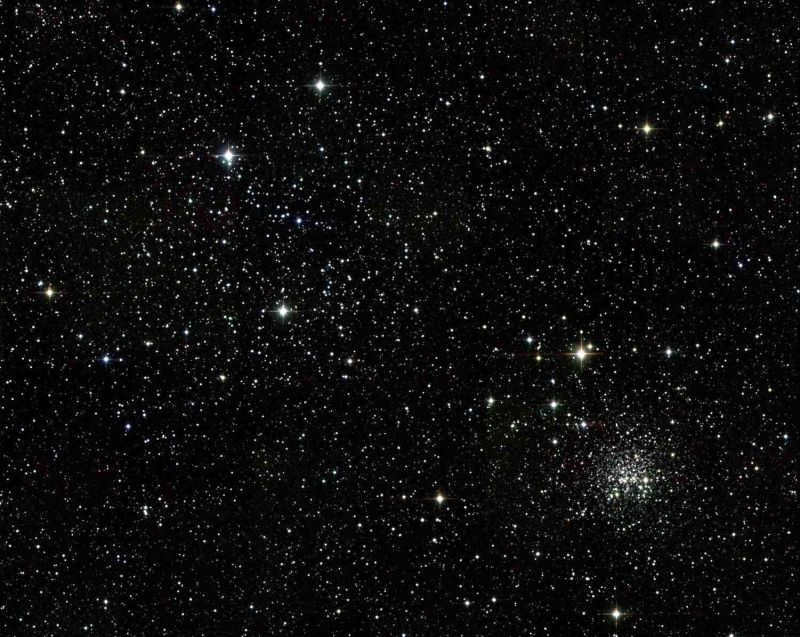
Sky enthusiasts who are up for the challenge can also observe two faint planetary nebulae in the constellation of Gemini. These nebulae are composed of gas that has accumulated around dying stars similar to our Sun. One of them is known as the Eskimo Nebula (or NGC 2392). Captured by the Hubble Space Telescope, it is located approximately 4,000 light-years away from Earth. To locate it, direct your gaze to the left of Pollux’s waist (marked as 2392 on the map). The second object is called the Medusa Nebula and can be quite challenging to spot. Look for it near the border with the constellation Canis Minor, just below Pollux’s knee.
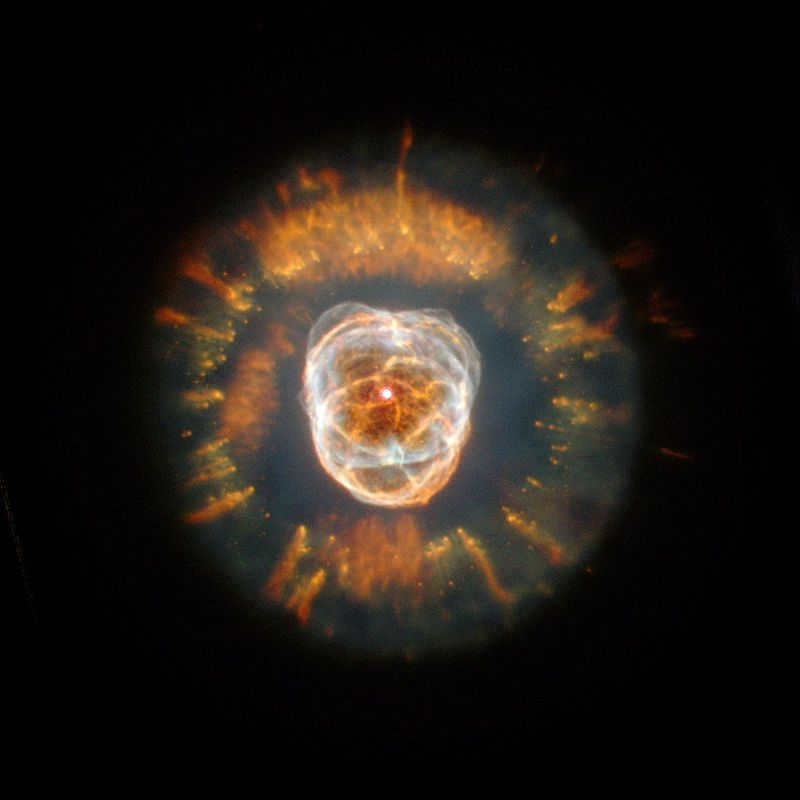
Every year, on December 13-14, meteor shower enthusiasts eagerly await the arrival of the Geminid meteor shower. This particular shower is caused by the debris left behind by the asteroid 3200 Phaethon as it orbits the Sun. Although these meteors do not originate from the Gemini constellation, they appear to “radiate” from that direction. During a particularly fruitful year, observers may be lucky enough to witness around 100 meteors per hour from this particular stream.
Gemini’s Influence on Modern Culture
Gemini has played a significant role in various aspects of contemporary culture, including space science, astronomy, and even science fiction. The Gemini missions conducted by NASA were aptly named after this constellation as they involved sending two astronauts into space. This choice of name highlights the twin-like nature of the star constellation. Additionally, the Gemini Observatory, which boasts two domes located in Hawaii and Chile, draws inspiration from the dual nature of the star twins.
Furthermore, Gemini has also made its mark in the world of literature. Renowned science fiction writer, Robert A. Heinlein, paid homage to the constellation by naming two of his teenage characters after its two prominent stars, Castor and Pollux. This demonstrates the enduring appeal and fascination that Gemini holds, not only in scientific communities but also in the realm of storytelling.
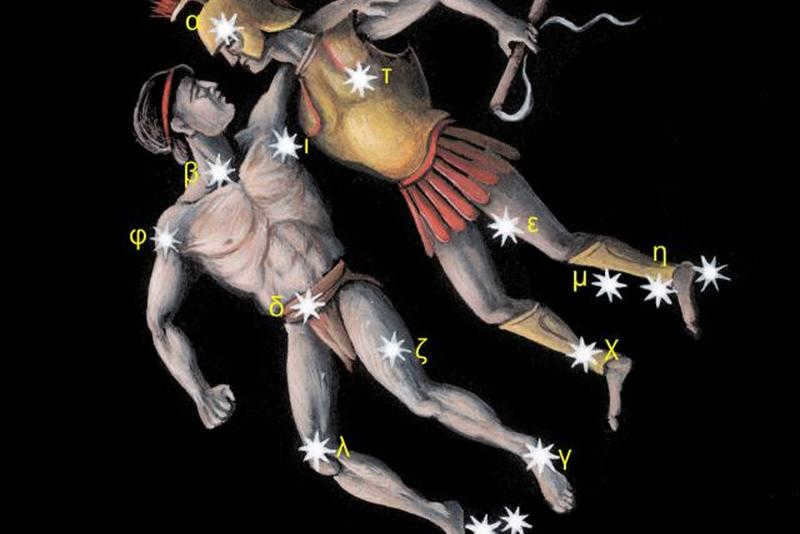
The constellation Gemini is known for its distinctive shape, which resembles two stick figures holding hands. The two brightest stars in the constellation, Castor and Pollux, take the form of twin heads. Gemini is considered the easiest constellation to identify due to its unique formation. Both the astrological sign of Gemini and the constellation itself are associated with the concept of duality. The myths and legends surrounding Gemini further emphasize this dual nature.
Gemini is a constellation known for its brightness in the night sky. Its appearance resembles two people or twins standing side by side, and it is easily identifiable due to its distinct shape and the presence of the two brightest stars, Castor and Pollux.
Spotting the Twins
While the twins may be obscured by bright sunlight and not visible during late spring and early summer in the northern hemisphere or late fall and early winter in the southern hemisphere, they illuminate the early evening sky from January through May. The best time to observe the zodiacal constellation Gemini is during January and February, regardless of your location in the world. At this time, it reaches its highest point around 22:00 local time.
How to locate the constellation Gemini in the sky
There are a couple of methods that astronomers recommend for finding the constellation Gemini:
- Locate the constellation Orion. Once Orion is in the southern sky of the northern hemisphere, you will be able to spot Gemini to the northwest of Orion.
- Spot the Big Dipper first, then identify the stars in the bowl of the Big Dipper. The star that connects the cup and the handle will guide you to Pollux. From there, imagine a line extending from the cup and handle; continue along that line and it will lead you straight to Gemini.
Utilize the celestial map
If you lack expertise in observing the night sky or admiring the stars, the most effective method to locate the Gemini constellation is to obtain a personalized star chart tailored to your specific sky-watching location.
- Starmap, which can be found on the Apple App Store, has the capability to transform your smartphone into a tool for identifying constellations.
- The Skyview application enables you to effortlessly point your iPhone towards the heavens to identify stars, constellations, and satellites.
Constellations of the Zodiac and the Astrological Zodiac
In ancient times, the zodiacal constellations aligned with the signs of the astrological zodiac. However, due to the precession of the equinoxes, this is no longer true. From a terrestrial perspective, the Sun passes in front of the zodiacal constellation Gemini, roughly from June 21 to July 20, while it is in the astrological sign of Gemini, which is roughly from May 21 to June 20. When the Sun is in the astrological sign of Cancer, its background is the constellation Gemini.
Constellations versus Sun Signs
While the twelve constellations and astrological signs share the same names, they are not interchangeable.
- Constellations are formations of stars that are visible from Earth. The 1515 Almagest by Ptolemy, an astronomer and astrologer, listed 48 constellations. The International Astronomical Union (IAU) defined the boundaries of these constellations in 1930. The zodiacal constellations refer to the 13 constellations that intersect with Earth’s ecliptic.
- The astrological zodiac, on the other hand, is based on the changing seasons on Earth. It divides the ecliptic into twelve segments of space, each spanning 30 degrees. Each of the 12 signs in the astrological zodiac represents a 30-degree arc along Earth’s ecliptic.
The astrological impact of Gemini
According to the early Persian Muslim astrologer Albumazazar, the constellation Gemini symbolizes exceptional intelligence, a broad perspective, and a kind and generous nature. This emphasis on having an open mind is evident in the volatile and ever-changing nature of Gemini, as well as its ruler Mercury, a planet associated with constant movement. Gemini represents individuals who are intellectually inclined and receptive to a wide range of subjects, ideas, and viewpoints. It is characterized by its inherent duality, curiosity, mental agility, and lack of emotional attachment.
The fixed stars of Gemini
The fixed stars of Gemini undergo a displacement of approximately one degree every 70 years. While not all astrologers incorporate them into their practice, some utilize a select few, recognizing their significance in enriching the depth of their interpretations.
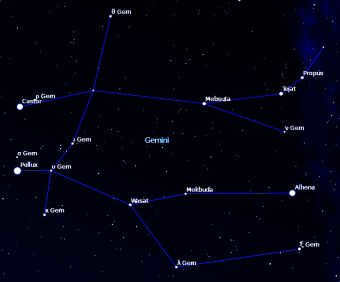
In case a fixed star’s sign and degree aligns with or opposes a planet in the birth chart, particularly the Sun, the chart ruler, or one of the angles, the impact of that star will be heightened on the individual’s life events and character. Currently, all the stars within the Gemini constellation are situated in the zodiac sign of Cancer.
The Fixed Stars Castor and Pollux
Castor and Pollux are the most brilliant stars in the Gemini constellation. Currently, Castor is positioned approximately at 20 degrees while Pollux is at 23 degrees of Cancer.
- Castor, known as the mortal twin, grants fame, intelligence, success in law, a propensity for travel, a love for horses, sudden recognition and honor. However, these blessings are often followed by financial loss, disgrace, illness, troubles, and immense suffering. Castor is also associated with mischief and violence.
- Pollux, the Immortal Twin, possesses a cunning, energetic, bold, daring, violent, and reckless nature. Pollux is connected to the love of boxing, dignified anger, and is associated with poisons.
- Pollux, when aligned with the Sun in Cancer, suggests that an individual will opt for the route that presents the most challenges, as it offers the greatest potential for personal development and growth. This path is characterized by its constant struggle against obstacles, with the individual prioritizing their own unique ideas and perspectives. A notable example of this alignment can be seen in figures such as Angela Merkel and Nelson Mandela, both of whom possess Pollux in conjunction with the Sun in Cancer.
Additional Gemini stars
Within the zodiacal constellation Gemini, there are 11 identified fixed stars. Some of these stars include:
- Tejat Pryor, located in the left leg of Castor, bestows strength, renown, and achievement.
- Tejat Posterio, situated in the back leg, grants vigor, vitality, authority, and safeguarding.
- Alchena, known as the shining one, brings fame in the arts, but also carries the responsibility for accidents involving the feet.
Geminids Meteor Shower
The annual Geminids meteor shower, which derives its name from the constellation Gemini where it appears to originate, is a highly anticipated event for skywatchers.
If you are observing the Geminids from the Northern Hemisphere, you can start spotting meteors as early as December 6. Initially, only one meteor per hour will be visible, but as the week progresses, the rate increases dramatically, peaking at 50-80 meteors per hour on the night of December 13-14. After that, the frequency gradually decreases, and the last Geminids can be seen on December 18.
Many astronomers believe that meteor showers bring something new and significant, associated with the energy of the constellation they originate from. In the case of the Geminids, it is believed that fresh ideas will shower the Gemini area of each person’s natal chart.
Legends linked to the constellation of Gemini
Various civilizations have diverse narratives connected to the Gemini constellation and its two most prominent stars. In China, it symbolized the comprehension of the Yin Yang philosophy, representing the opposing forces of nature. References to Gemini can be found in ancient Persian texts and Babylonian astronomy. The Romans associated it with twin brothers named Romulus and Remus, while the Greeks referred to it as twin brothers Castor and Pollux.
The Legend of Castor and Pollux
According to one myth, the birth of Castor and Pollux, as well as their twin sisters Helen and Clytemnestra, was quite extraordinary. It is said that they hatched from an egg laid by their mother Leda, who was the Queen of Sparta. The intriguing part is that Leda was seduced by Zeus, who had taken the form of a swan. This unusual union resulted in the birth of these legendary siblings.
On the other hand, another version of the story suggests that Castor and Pollux had different fathers. Pollux, being the son of Zeus, was blessed with immortality, while Castor, the son of Leda’s husband King Tyndareus, was mortal. Despite their different parentage, Castor and Pollux shared an unbreakable bond as brothers and were inseparable throughout their lives.
After the death of Castor, Pollux, who was the immortal one, was filled with sorrow and pleaded with his father to grant his brother half of his immortality. In response, Zeus transformed them into the constellation Gemini, and as a result, the twins divide their time equally between the heavenly realm and the underworld. This is why the twins appear to vanish from the sky during specific periods throughout the year.
The legend of Romulus and Remus
There is some debate surrounding the paternity of Romulus and Remus. Some claim that they were the sons of Hercules, while others maintain that their mother, Rhea, was a chaste Vestelian virgin who was violated by an unknown man and insisted that her pregnancy was a result of divine intervention. Alternatively, another tale suggests that Rhea was wedded to Mars, the Roman god of war, and that Romulus and Remus were their twin offspring.
In one version of the myth, King Amulius imprisons Rhea and commands a servant to execute her twin infants. However, the servant takes pity on the babies and instead places them in a basket, which he then sets adrift on the Tiber River. It is there that they are discovered by the she-wolf Lupa, who adopts them as her own and nourishes them. As they grow older, Lupa leaves them in a place where they can be found by a shepherd. The shepherd and his wife take in the twins, who mature into adulthood while tending to their flock of sheep.
Astrological Gemini
The astrological calendar commences when the Sun enters the zodiac sign of Aries: the mythological and symbolic representation of a ram. Subsequently, the Sun transitions into the zodiac sign of Taurus, which is symbolized by a mighty bull. Following Taurus is Gemini. Gemini, being the third astrological sign in the zodiac, possesses specific dates for each individual sign (as seen on a chart). Furthermore, Gemini is unique as it is the first zodiac sign to be represented by a human being. However, it is not just a singular individual; it embodies the duality of twins, each possessing their own distinct thoughts and perspectives. Gemini is an ever-evolving and versatile astrological sign, characterized by its mental agility. In fact, it is the Gemini sign that compels one’s intellect to differentiate between the self and the external world.
Gemini is a widely recognized constellation, potentially owing to its affiliation with the zodiac. While it may not appear particularly striking in the night sky, its prominent stars, Castor and Pollux, offer a luminous and easily identifiable presence. Furthermore, Gemini harbors a plethora of intriguing celestial entities, making it a captivating subject for observation.
A glimpse into mythology
The constellation Gemini has been recorded since ancient times, and there exist various myths surrounding it. In Greek mythology, the prominent stars of the constellation, Castor and Pollux, symbolize two twin brothers. These brothers were born to Leda, the queen of Sparta, who was renowned for her exceptional beauty that even the god Zeus could not resist. Zeus, in order to avoid being recognized by his divine wife Hera, transformed himself into a swan and slipped into Leda’s presence through a window. Consequently, Leda gave birth to Pollux and Helen. The Romans referred to Pollux as Polydevk. Interestingly, Helen, who possessed unparalleled beauty, later became the catalyst for the Trojan War.
At the same time as Pollux and Helen, Leda also bore two more children – a son named Castor and a daughter named Clytemnestra. However, their father was Leda’s lawful husband, a king named Tyndarus from Sparta. Therefore, Castor was a regular mortal man, while Pollux was immortal, as he had a divine parent who ensured his immortality.
Castor and Pollux grew up side by side and eventually became renowned heroes. They participated in the famous Argonauts’ expedition and accomplished numerous great deeds. Pollux was a famed boxer, while Castor excelled in horseback riding and fencing – it is said that he even trained Hercules himself. The twins had a deep bond and were always together.
However, tragedy befell the twins one fateful day. Castor and Pollux had two cousins, Linkeus and Id, who were also twins. In a heated argument, Id fatally wounded Castor with a spear. Pollux engaged in a fierce battle with Id, but their strength was evenly matched, and the fight dragged on. Eventually, Zeus intervened and hurled a thunderbolt that struck down Id.
The grief that consumed Pollux was insurmountable. He beseeched his divine father to strip him of his immortality so that he could join his beloved brother in the underworld realm of Hades. After much negotiation, a compromise was reached. Pollux would spend one day with his brother in the realm of Hades, and on the following day, the two of them would ascend to the realm of the gods on Mount Olympus.

Castor and Pollux are a pair of inseparable siblings.
That is how the brothers found themselves in the heavens, transforming into celestial bodies that serve as a constant reminder of genuine brotherly affection. In ancient Greek mythology, they were revered as deities who safeguarded travelers from any misfortunes they encountered in unfamiliar territories.
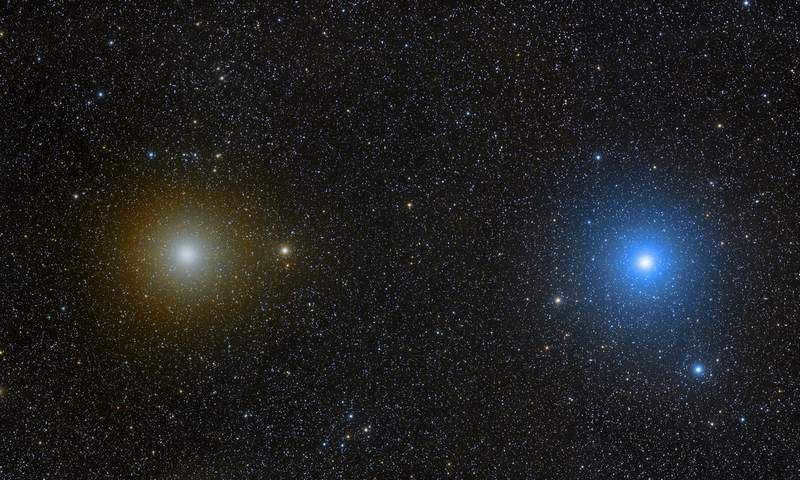
Pollux (on the left) and Castor (on the right) – this is how they appear in the celestial sphere.
This is such an intriguing tale, filled with emotions, that is linked with the constellation Gemini.
The Gemini constellation in the celestial sphere
This particular constellation is classified as a winter constellation, making it most visible during the fall season when it starts to rise in the eastern sky during the evening hours, and continuing until spring, when it remains above the western horizon.
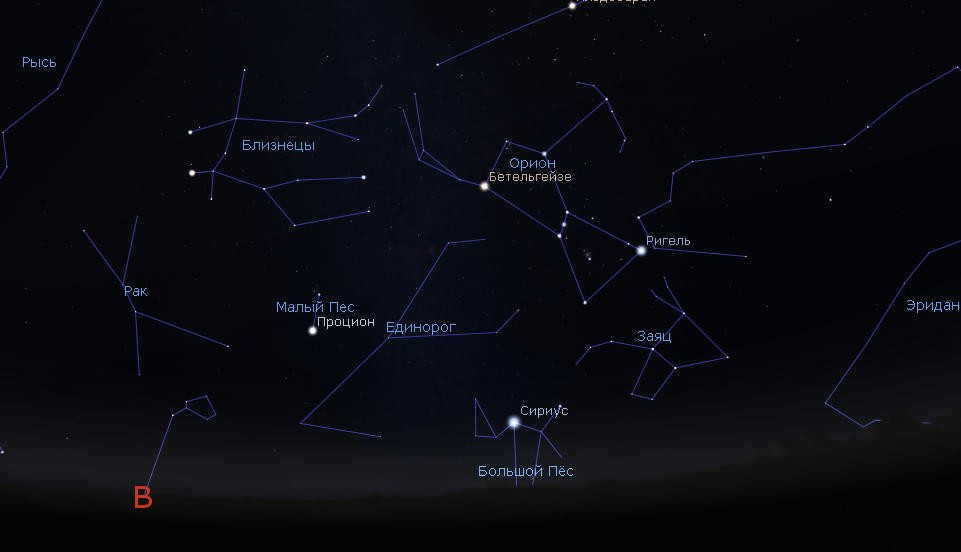
The Gemini constellation can be observed in the night sky, with the help of the Stellarium planetarium.
Notable features of the Gemini constellation
There are several interesting celestial objects in this constellation that can be easily seen without any special equipment. Among them are a few unique stars and a star cluster called M35, which is included in the Messier catalog. In total, about 70 stars can be spotted with the naked eye in the Gemini constellation, and the Milky Way also contributes to its beauty.
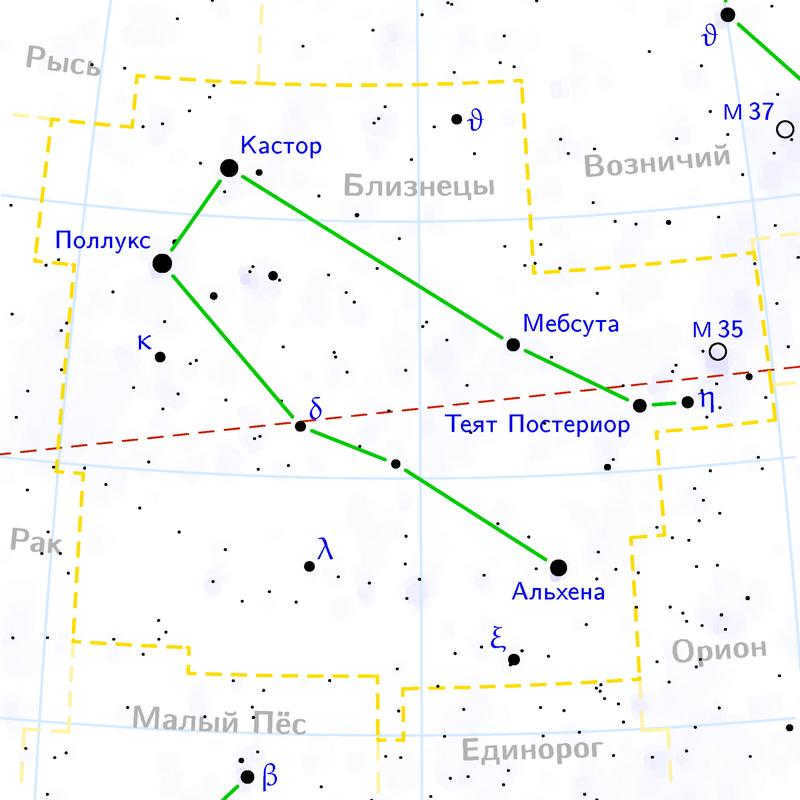
Constellation Gemini – Stars Highlighted
Among the many stars in the constellation Gemini, two that deserve special mention are Castor and Pollux. Additionally, there are also several variable and double stars present.
Castor serves as the leader of the constellation Gemini
It’s worth mentioning that even though Castor is designated as the “alpha” star, it is not actually the brightest star in Gemini – it is brighter than Pollux, which is labeled as the “beta” star. Castor has a brightness measurement of 1.59m, while Pollux has a brightness measurement of 1.16m.
Castor is an extraordinary star. When observed through a small telescope, such as a refractor with an aperture of 70-90mm, one can observe that this star is actually a double star system – with its components separated by an angular distance of 4″. These components, known as A and B, have brightness measurements of 2.0 and 2.9m respectively, and they orbit around a common center of mass with a distance of approximately 350 years. The duality of Castor was first discovered by William Herschel in 1804, who also calculated the orbital period of the stars in the system.
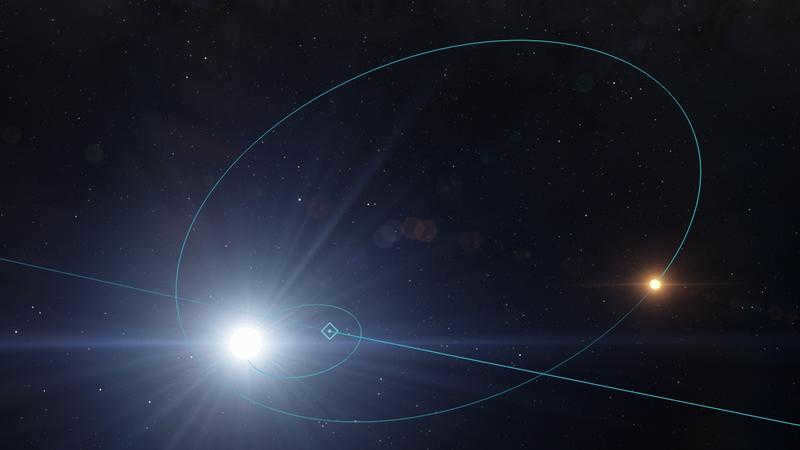
Components A and B in the Castor system are quite similar. Each is composed of a pair of stars – a hot white star with a mass of approximately 2 solar masses, and a red dwarf with a mass of 0.7 solar masses.
But that’s not all! At a distance of 73″ from these two stars, there is a faint star with a brightness of 9m, which even has its own designation, YY Gemini. YY Gemini.. Thus, this star serves as the third component of Castor, and it also orbits the first two stars around a central point of mass. Due to the significant distance, the orbital period is tens of thousands of years. Despite a century and a half of observations, the motion of Castor C relative to the other components of the system has yet to be detected, indicating that it is incredibly small.
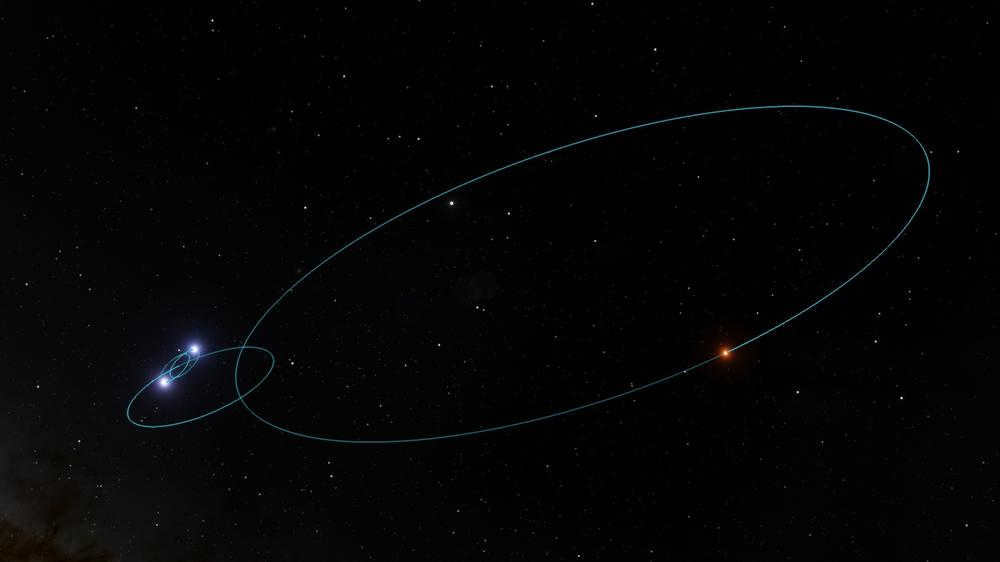
The Castor system is composed of three bright stars, each of which is also a close binary system. This interesting configuration was captured in a screenshot from the Space Engine program.
However, the uniqueness of the Castor system does not end there. Castor C is actually a double star as well, and it is incredibly close. This component consists of a pair of red dwarf stars with a mass of approximately 0.6 times that of the Sun. They are separated by a mere 2.7 million kilometers and their orbits are aligned in such a way that Castor C appears as an eclipsing variable star with a period of 19 days.
Castor, also known as alpha Gemini, is an extraordinary system with a total of six suns. It features two white hot stars and four red dwarfs, all located nearly 50 light years away from us. Every few tens of thousands of years, all the stars in the system come into close proximity to one another. If there were planets in this system, the sky would present a truly remarkable sight during these encounters.
Pollux: Gemini’s Beta Star
After witnessing the stunning spectacle of Castor’s six-star system, Pollux doesn’t hold as much surprise. As the brightest star in the constellation Gemini, it shines with a magnitude of 1.15 and resides 33.7 light-years away from our planet.
Remarkably, Pollux is a typical red giant that has nearly exhausted its helium supply. Over the next hundred million years, it will shed its outer layers and transform into a white dwarf.
In 1993, astronomers suspected the presence of a planet orbiting Pollux. Their suspicions were confirmed in 2006 when an exoplanet, twice the mass of Jupiter, was discovered. When a naming contest was held for this newfound planet, one suggestion was to name it Leda, in tribute to the mother of the Gemini twins. However, this name was already assigned to an asteroid and one of Jupiter’s moons, so it was ultimately named Thestias. Here’s how it appears in the Space Engine program:

Exoplanet Thestias illuminated by the radiance of Procyon. Captured from the Space Engine software.
In the coming times, the residents of any other exoplanets or moons, particularly those suitable for life, will face imminent catastrophe.
Other fascinating stars in the Gemini constellation
In this constellation, there exists an eclipsing variable star known as U Gemini. This particular system comprises of red and white dwarfs that are situated in such proximity to one another that material from the red star flows onto the white star. They revolve around each other in a mere 4 hours and 11 minutes. When the white dwarf accumulates a significant amount of extraneous matter on its surface, thermonuclear reactions are triggered, resulting in a dazzling flare-up of the star.
Due to this occurrence of bursts of brightness, an English astronomer named John Russell Hynde mistakenly identified this star as a new one in 1855. However, it was later revealed that these bursts are actually recurring. The average brightness of U Gemini is approximately 14.2m, making it visible through a fairly powerful telescope with an aperture of 150mm or larger. During a burst, the brightness increases to 8.8m, allowing for visibility through any telescope or even high-quality binoculars. These bursts reoccur at varying intervals, ranging from 62 to 257 days.
Gemini Delta (Vasat) is a binary star system, where the components are physically bound together by gravity. The angular separation between the yellow subgiant and the bright red dwarf, which has a brightness of 8.2m, is 6.8″. There is a possibility that the bright component itself is a close binary system, which would make this a triple star system.
The Star Cluster M35
Located in the western region of the Gemini constellation, there is a diffuse star cluster known as M35. With a magnitude of 5.3, it is possible to spot this cluster with the naked eye on a dark night. In binoculars, it appears as a hazy patch with a few individual stars.
If you have access to a telescope, you can observe the M35 cluster in greater detail. When using a telescope with a small aperture and low magnification, the cluster becomes even more impressive due to the wider field of view. This celestial object left a lasting impression on the renowned 19th-century astronomer, Lassel, earning it the title of the “Gemini constellation’s pearl.”
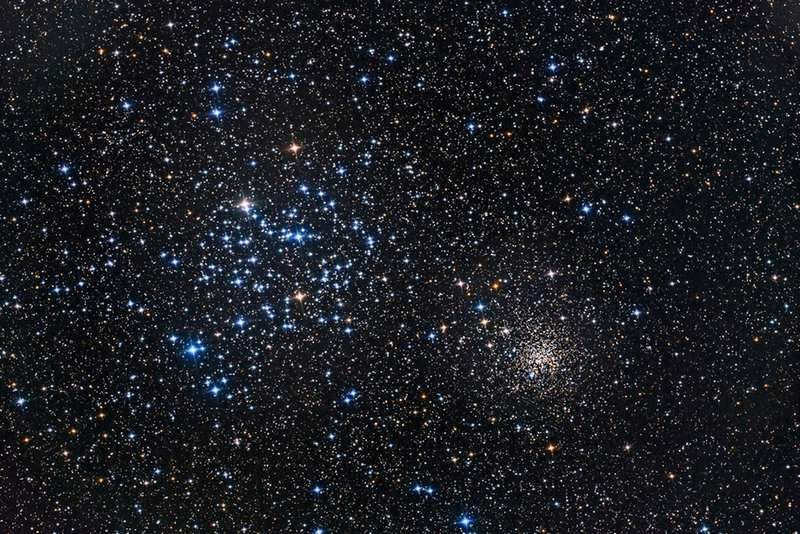
Scattered star clusters M35 (on the left) and NGC 2158 (at the bottom right)
Adjacent to M35, there exists another dispersed cluster known as NGC 2158. This cluster has a brightness of 8.6m and is dimmer and more compact. To observe it as individual stars, a telescope with a larger aperture and higher magnification is required, although it can still be seen without much detail using an 80-90 mm refractor.
In the vicinity of M35, there are also several nebulae that complement the overall composition when photographing together. However, capturing them in a single frame necessitates the use of a telescope with a larger aperture.
👬🏼 The constellation Gemini symbolizes the loyal brotherly bond between Castor and Pollux.
Pollux, the son of Zeus (Jupiter), was granted the gift of immortality, while his brother Castor remained a mortal. Castor became renowned for his extraordinary talent in horse control and chariot driving.
P.S. In astrology, it is now Gemini who governs over roads, cars, and overall logistics.
They also had two cousins with whom they were close. However, one day a disagreement arose between them, and Castor was fatally wounded by Idas, one of the cousins.
Upon Castor’s death, Pollux implored Zeus to make him mortal so that he could be reunited with his brother. His father presented Pollux with a choice: they could spend one day in the realm of the dead 💀 and another day on Olympus in the realm of the Gods if he desired to be with his brother. Without hesitation, Pollux agreed, and since then, they have never been apart.
Mercury, the ruler of Gemini, is considered neutral in any astrological chart as it exhibits a calm demeanor in both positive and negative aspects, interacting harmoniously with other planets.
Castor and Pollux shared an inseparable bond that exemplified the true essence of brotherly love, which ultimately granted them a place in heaven.
The Gemini constellation can be observed from various locations in Russia during the months of December and January. Castor and Pollux, the two brightest stars ⭐️ ⭐️ in this constellation, shine brightly in the night sky.
Share your zodiac sign in the comments section below, and I will write the next legend about those who receive the most responses. 👌🏽
Let’s delve deeper into this topic by exploring the origins, discovery, and intriguing facts surrounding it.
What the Gemini constellation looks like
The Gemini constellation has the shape of a rectangle. You can visualize this shape by connecting the brightest stars in your mind.
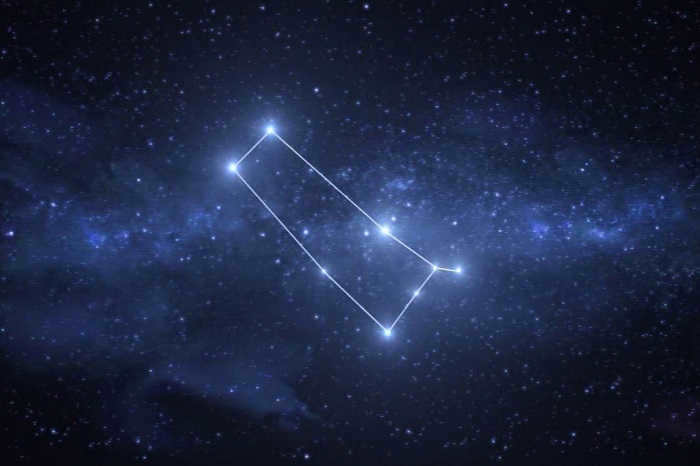

The symbol of the Gemini constellation is derived from two connected vertical lines. There are other stars next to this symbolic rectangle, but they are not as prominent.
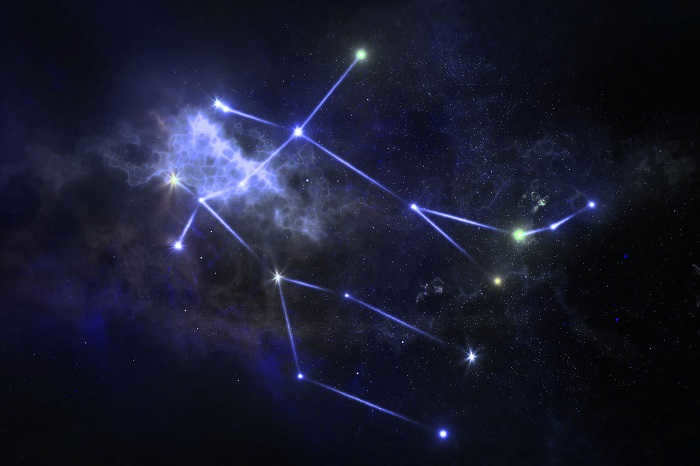
When you look at maps and charts, you will see that Gemini is represented by the outline of two individuals, as if they are holding hands.
The story and historical background of the constellation
The interpretation of Gemini varied among different cultures. Some depicted it as a man and a woman, while ancient Babylonians associated it with a shepherd and a warrior. The ancient Greeks, on the other hand, perceived it as two inseparable brothers.
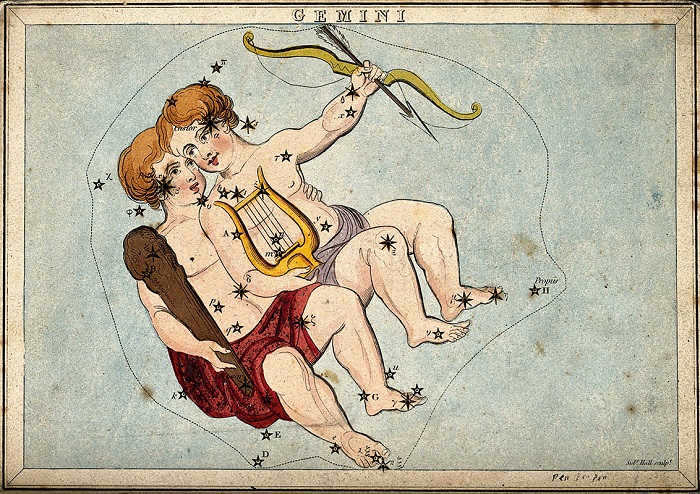

There is a mythological tale surrounding these twins in ancient Greek legends.
The mother of the twins was Leda, the spouse of King Tyndareus of Sparta. She possessed an exceptional beauty that even caught the attention of Zeus himself. However, Zeus was hesitant to meet Leda due to his wife Hera’s potential jealousy. To overcome this obstacle, he transformed into a swan and flew to Sparta.
Leda and Zeus became the parents of two children – Polydevk (Pollux) and Helen the Beautiful, whose beauty ultimately sparked the Trojan War. Leda also bore two children from her husband – Castor and Clytemnestra. Zeus granted his own son, Polydeucus, with immortality as a reward.
Despite having different fathers, the brothers remained inseparable throughout their entire lives. They both chose to marry their sisters, Phebe and Gillaira. However, in order to do so, they had to abduct the girls from their suitors, Linkeus and Idas.
There are two conflicting accounts of Castor’s death. In one version, he was killed by his cousin, Idas. In the other version, he was slain by his rival, Idas. Polydevk was devastated by the loss of his brother and was unwilling to let him go. He pleaded with Zeus to grant him mortality so that he could join his brother in the realm of the dead.
Zeus agreed to Polydevk’s request, but with the condition that he would spend one day on Olympus and one day in the kingdom of Hades. However, Zeus soon realized the depth of the brothers’ bond and decided to transform them into stars, ensuring that they would never be separated.
The main stars of the Gemini constellation
The most prominent stars in this constellation are Pollux (beta Gemini) and Castor (alpha Gemini). The stars in this constellation are designated using the Greek alphabet, with the brighter stars having higher letter designations.
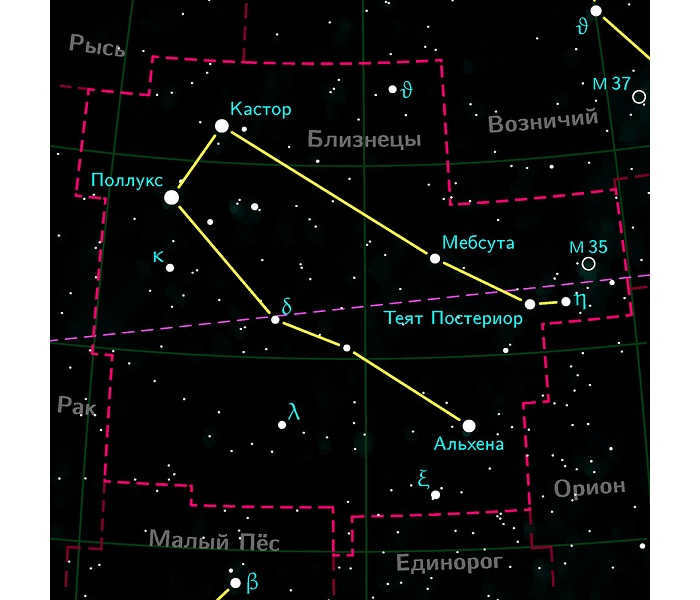
In this particular situation, however, the designations are organized in a slightly different manner.
Pollux, being the brightest star, is positioned at a distance of 33.7 light-years from our solar system. The second brightest star is Castor.
Castor is quite an extraordinary star. It is a multiple star system, meaning it consists of several stars, in this circumstance, precisely 6 stars. Hence, Castor belongs to multiple spectral classes simultaneously (stars are categorized into spectral classes based on their temperature).
Alchena, on the other hand, can be observed with the naked eye. It is situated directly across from Pollux.

Additionally, there are several dozen other stars within the Gemini constellation. A few of these stars are visible with regular binoculars, while others can only be seen using a high-powered telescope.
Aside from the stars found in the constellation of Gemini, there are also two other celestial objects worth mentioning: the Eskimo planetary nebula (NGC 2392) and the scattered star cluster M 35.
There have also been discoveries of planets orbiting multiple stars.
Observations of Constellations
The constellation Gemini can be seen from late autumn to spring. Skilled astronomers locate celestial objects using coordinates. For beginners, it is recommended to learn how to find desired objects using other stars and constellations.
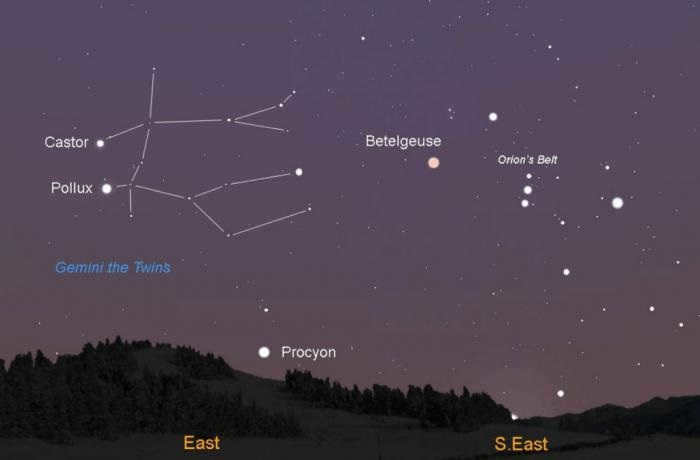

Locating the Gemini constellation is a simple task when using the Orion constellation as a reference point. Gemini can be found in the eastern direction.
It is important to note that the time of observation plays a significant role. For instance, during early winter, Orion will appear in the east shortly after sunset. However, due to the movement of constellations across the sky, Orion will already be in the south before dawn.
By examining a picture or photograph of the starry sky, one can observe that the brightest stars of Orion form two triangles with a belt consisting of three stars in the center.
Gemini is situated to the northwest of Orion. An identifying marker is Orion’s prominent top star, Betelgeuse, which points towards Pollux.
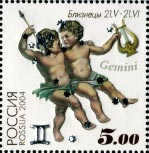
Gemini is a constellation that symbolizes two siblings who are twins, known as Castor and Pollux. According to the myth, they were half-brothers but grew up together and were inseparable, just like real twins. Castor was a mortal while Pollux was immortal.
As they reached adulthood, the brothers played a role in the Trojan War and successfully brought their sister, the beautiful Helen, back to Greece from Troy. They also joined the Argonauts in their quest for the golden fleece, always supporting each other. Furthermore, the twins were among the greatest heroes of Greece and took part in the hunt for the Calydonian boar, which they managed to defeat despite its immense size and ferocity.
During one of their military campaigns, Castor tragically perished, leaving his brother Pollux devastated. In a desperate plea to Zeus, Pollux begged for death so that he would not be separated from his beloved sibling. Zeus, moved by their unbreakable bond, devised a unique arrangement. He decreed that the brothers would spend alternate days: one day dwelling in the somber kingdom of Hades with the shadows, and the next day frolicking amongst the gods on the radiant mountaintop of Olympus. This celestial phenomenon is mirrored in the night sky by the constellation Gemini, symbolizing friendship and loyalty.
Within this constellation, two luminous stars shine in close proximity to one another. The shape of the constellation strikingly resembles two human figures, leading people to believe that these stars represent the inseparable brothers of Helena the Beautiful – Castor and Pollux.
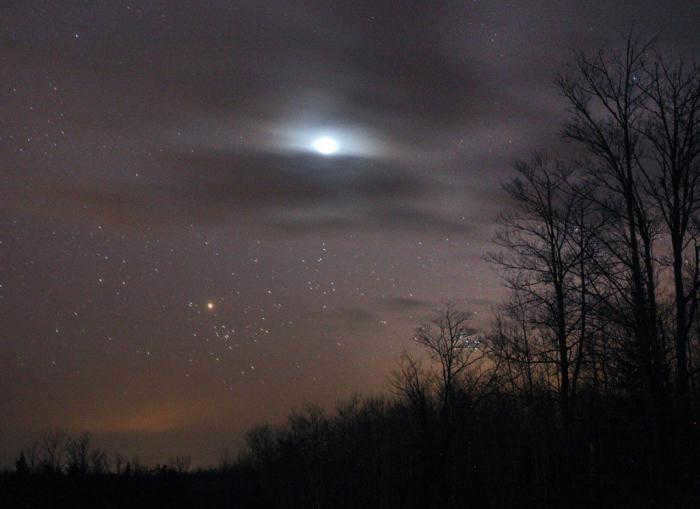
Description of the Gemini Constellation
To begin the tale of the Gemini constellation, it is necessary to provide its description. This particular region of the celestial sphere is positioned perpendicular to the Milky Way. The stars within it create the shape of an almost flawless rectangle. On a clear evening, the naked eye can behold approximately seventy stars. Amongst these, the most brilliant are known as Castor (referred to as the “coachman”) and Pollux (known as the “fist fighter”). The remaining stars form two parallel chains. However, the depiction frequently found in ancient star charts – two inseparable twin brothers locked in an embrace – is not easily discernible in the night sky. Modern constellation charts also do not present such an image.
The Castor system is comprised of multiple luminaries, forming a complex celestial arrangement. It is located approximately 46 light-years away from the Sun. Pollux, on the other hand, is a yellow-orange giant star with a luminosity that is thirty-five times greater than that of the Sun. Despite its impressive brightness, Pollux is considerably colder compared to its celestial sibling. If one were to embark on a journey to reach this distant star, they would have to traverse a staggering distance of thirty-five light-years.
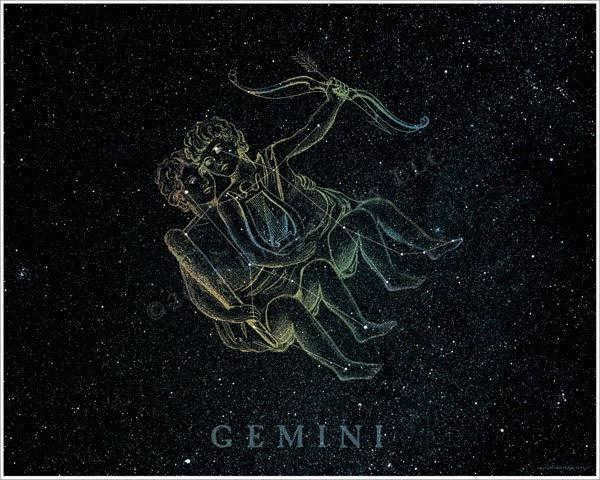
Fascinating Objects in the Gemini Constellation
Within the Gemini constellation, there exist incredibly captivating objects. Some of these objects are visible to the naked eye. These phenomena frequently undergo changes that captivate the attention of scientists. For instance, U (ipsilon) of Gemini possesses extraordinary characteristics. It is classified as a variable cipheid, meaning it undergoes periodic fluctuations in brightness. This occurrence transpires approximately every 102 days due to powerful explosions transpiring on its surface. If you examine constellation charts meticulously, you will notice that this star resides in the position where the “heart” of Pollux should be situated.
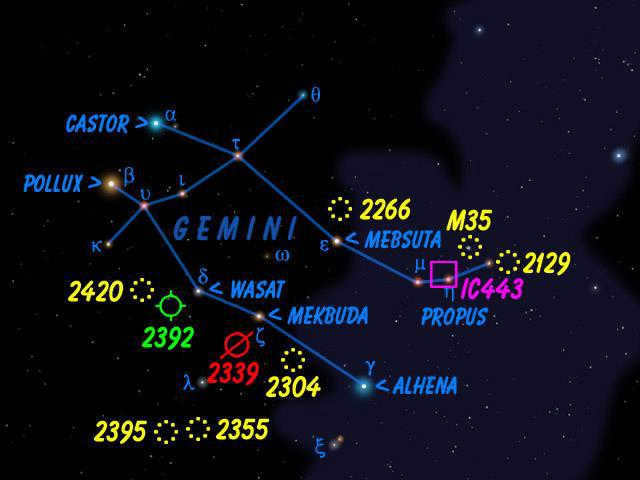
Notable Objects. Shooting Stars and Cosmic Clouds
In the vicinity of Castor in the Gemini constellation lies the radiant point of a meteor shower known as the Geminids. This celestial event can be witnessed from December 7 to December 15, with the peak activity occurring on December 13. During this time, the number of shooting stars can reach up to 60 per hour.
In close proximity to the stars Mu and Zeta Gemini, one can observe a faint spot visible to the naked eye. This spot is actually a cluster of 120 stars, referred to as M35, and is particularly captivating when observed through a telescope or binoculars. It is located at a distance of 830 parsecs from the Sun.
Research History
The use of stars for navigation has been a practice since ancient times. Different cultures assigned different names to the celestial bodies. However, there were always two bright stars that were considered inseparable. According to Greek mythology, these stars were known as Castor and Pollux, the Dioscuri brothers and the sons of the Spartan king Tindareus and the Olympian god Zeus. This specific section of the night sky is included in the astronomical catalog called “Almagest,” which was compiled by Claudius Ptolemy in 140 AD. The ancient Babylonians also viewed this constellation as a pair that couldn’t be separated. They referred to the brightest stars in it as the “shepherd and warrior.” The Thracians believed that these stars were twin brothers who aided sailors in finding their way back home.
Two significant scientific breakthroughs are linked to the history of astronomy and the Gemini constellation. In 1781, W. Herschel discovered the planet Uranus near the bright star Propus within this constellation. Another explorer, C. Tombaugh, made a groundbreaking discovery in 1930 by finding Pluto, which is closely located to the star Vasat, another member of the Gemini constellation.
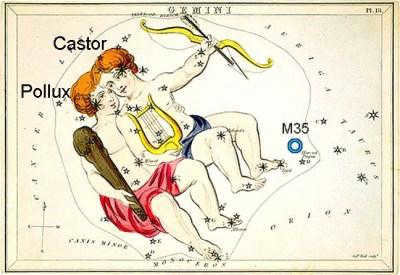
Observation
Finding the Gemini constellation in the night sky may not be an easy task, especially for children. However, it can be easily located due to its distinct and unique pattern. Gemini is composed of two parallel chains of stars and can be found northeast of Orion. The “parachute” of the Ascendant constellation should be northwest in relation to Gemini. Gemini is part of a group of prominent constellations in the sky, moving westward along with Taurus and slightly ahead of Leo, which moves eastward.
In January and December, you have the opportunity to observe the constellation Gemini in all its glory. Each year, on June 21st, the Sun aligns with this constellation, causing it to appear high above the horizon and easily visible from all across our country.
Mythology. The Genesis of the Twins
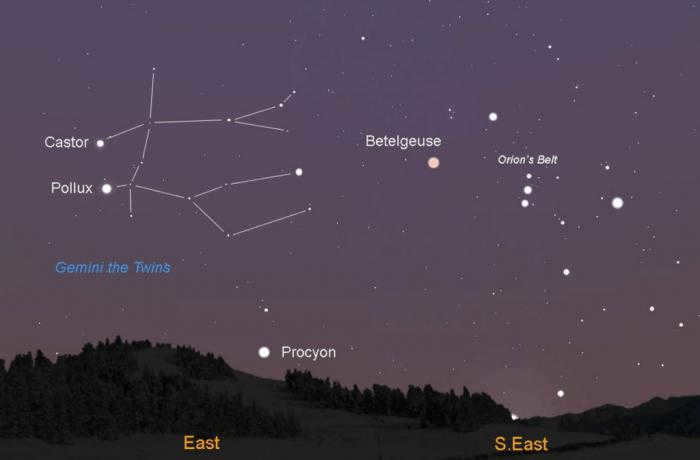
Mythology. Heroic Achievements
The tale of the Gemini constellation recounts that as the brothers matured, they transformed into exceptional athletes. They accomplished numerous renowned feats. The Dioscuri assisted Jason in acquiring the coveted golden fleece. Castor possessed unparalleled expertise in taming and skillfully maneuvering chariots. Pollux proved unbeatable as a fist fighter. The brothers consistently acted in unison. On one occasion, they abducted King Livkippus’ daughters, Theba and Gelaira. The boys managed to snatch the girls right from under the king’s nose and wed them. Polydevk chose Pheba, while Castor chose Gelaira. Consequently, the brothers of Apharetides (Idas and Linkeus), whose brides were stolen by the Dioscuri, became their sworn adversaries. In battle, Idas ultimately slew Castor.
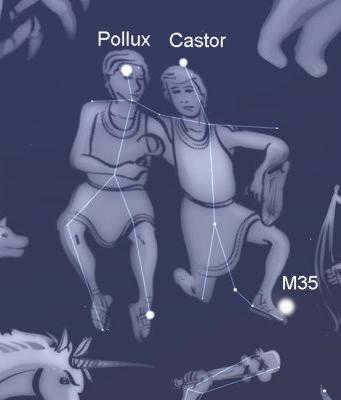
Mythology. A Tale of Brotherly Affection
The final tale of the brothers recounts how the constellation Gemini came to be seen in the celestial sphere. This aspect of the narrative holds particular significance for young ones, as it illustrates the concept of selfless fraternal affection. Following Castor’s demise, Polydeuces beseeched Zeus to grant him mortality. The valiant hero was willing to dwell in the subterranean darkness of Hades, so as to remain forever united with his brother. The Thunderer felt remorse at condemning his son to such a gloomy fate. Thus, he granted Polydeuces’ request, yet decreed that he must spend one day on Olympus and another in the realm of the deceased. The ancient Greeks revered the inseparable twins as guardians and defenders of humanity. Witnessing the indissoluble bond between Polydeuces and Castor, Zeus transformed them into celestial bodies and positioned them in the heavens as a perpetual reminder of their unwavering loyalty and fraternal love.





